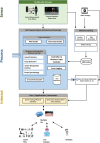Enhancing volleyball training: empowering athletes and coaches through advanced sensing and analysis
- PMID: 38689871
- PMCID: PMC11058639
- DOI: 10.3389/fspor.2024.1326807
Enhancing volleyball training: empowering athletes and coaches through advanced sensing and analysis
Abstract
Modern sensing technologies and data analysis methods usher in a new era for sports training and practice. Hidden insights can be uncovered and interactive training environments can be created by means of data analysis. We present a system to support volleyball training which makes use of Inertial Measurement Units, a pressure sensitive display floor, and machine learning techniques to automatically detect relevant behaviours and provides the user with the appropriate information. While working with trainers and amateur athletes, we also explore potential applications that are driven by automatic action recognition, that contribute various requirements to the platform. The first application is an automatic video-tagging protocol that marks key events (captured on video) based on the automatic recognition of volleyball-specific actions with an unweighted average recall of 78.71% in the 10-fold cross-validation setting with convolution neural network and 73.84% in leave-one-subject-out cross-validation setting with active data representation method using wearable sensors, as an exemplification of how dashboard and retrieval systems would work with the platform. In the context of action recognition, we have evaluated statistical functions and their transformation using active data representation besides raw signal of IMUs sensor. The second application is the "bump-set-spike" trainer, which uses automatic action recognition to provide real-time feedback about performance to steer player behaviour in volleyball, as an example of rich learning environments enabled by live action detection. In addition to describing these applications, we detail the system components and architecture and discuss the implications that our system might have for sports in general and for volleyball in particular.
Keywords: action recognition; digital sports technologies; smart sports; sports telematics; telematics applications; training methods.
© 2024 Salim, Postma, Haider, Luz, Beijnum and Reidsma.
Conflict of interest statement
The authors declare that the research was conducted in the absence of any commercial or financial relationships that could be construed as a potential conflict of interest.
Figures








References
-
- Hsu Y-L, Yang S-C, Chang H-C, Lai H-C. Human daily and sport activity recognition using a wearable inertial sensor network. IEEE Access. (2018) 6:31715–28. 10.1109/ACCESS.2018.2839766 - DOI
-
- Salim F, Haider F, Tasdemir SBY, Naghashi V, Tengiz I, Cengiz K, et al. Volleyball action modelling for behavior analysis and interactive multi-modal feedback. In: eNTERFACE’19 (2019).
-
- Salim FA, Haider F, Postma D, van Delden R, Reidsma D, Luz S, et al. Towards automatic modeling of volleyball players’ behavior for analysis, feedback, and hybrid training. J Meas Phys Behav. (2020) 3:323–30. 10.1123/jmpb.2020-0012 - DOI
-
- Thomas G, Gade R, Moeslund TB, Carr P, Hilton A. Computer vision for sports: current applications and research topics. Comput Vis Image Underst. (2017) 159:3–18. 10.1016/j.cviu.2017.04.011 - DOI
-
- Altimira D, Mueller FF, Clarke J, Lee G, Billinghurst M, Bartneck C. Digitally augmenting sports: an opportunity for exploring and understanding novel balancing techniques. In: Proceedings of the 2016 CHI Conference on Human Factors in Computing Systems. New York, NY, USA: Association for Computing Machinery, CHI ’16, (2016). p. 1681–91. doi: 10.1145/2858036.2858277.
LinkOut - more resources
Full Text Sources

